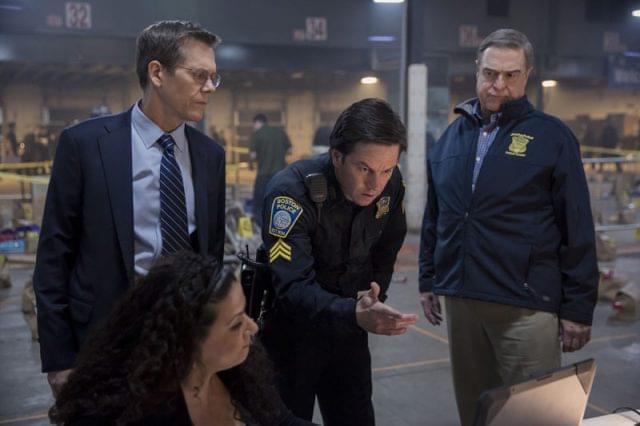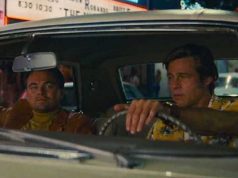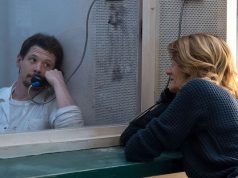
It’s hard to narrow it down, but the most damaging mistake in “Patriots Day” might be the choice to focus on a single fictional character but surrounding him with real people.
Peter Berg’s nakedly manipulative docudrama about the 2013 Boston Marathon bombing and subsequent manhunt strives for authenticity in almost every other regard. It’s the kind of movie that tells you people’s names and job titles when they first appear, what time of day it is, and how many hours it’s been since the blast. But when it comes to the protagonist — Boston cop Tommy Saunders, played by Mark Wahlberg — it’s a one-dimensional Hollywood rah-rah movie, with Tommy magically appearing at every critical moment and doing the things that in real life must have been done by at least a dozen different police officers.
It’s almost comical the way the movie treats him, like he’s the detective who caught the case and has to work every aspect of it. He’s at the finish line when the bombs go off; he’s giving the FBI advice on how to use the public’s help; he’s the cop who responds to the Chinese carjacking victim’s 911 call; he’s in Watertown for the shootout with the Tsarnaev brothers. Many hours after the bombing, when Tommy finally goes off-duty to get some rest, he’s immediately called back to the mobile command center. Why? Because the FBI (led by Kevin Bacon) has diagrammed the street where the bombs went off on a warehouse floor and they need Tommy to tell them which buildings are which. He knows that neighborhood really well, you see. And I guess Google Maps and the hundreds of other law-enforcement personnel who know that neighborhood really well were unavailable. Like Tommy Saunders is a crucial part of the investigation because he knows the Starbucks is next to the Chipotle.
On second thought, there’s another flaw that might be more critical. Berg begins in customary disaster-movie fashion, introducing us to all the major players before the marathon. Some of these people, like J.K. Simmons’ police sergeant in Watertown (the Boston suburb where the killers are eventually caught), don’t enter the story until much later. So throughout the film, Berg periodically cuts back to J.K. Simmons, going about his business, just waiting to be called up.
Anyway, that’s not the flaw I meant. That’s just funny. The flaw is that the screenplay — written by Berg and two other men, with two more men credited with “story by” because parts of their scripts got Frankensteined into Berg’s — sets out to tell the ENTIRE story: the bombing, the victims, the police, and the killers. But it’s really only about the investigation and manhunt. The result is that a few victims are introduced early on; injured in the explosions; rushed to hospitals … and then abandoned. We don’t see them again till the very end, when the film circles back around to say, “Oh, yeah, these people. They survived. They’re fine now. Isn’t that inspiring?” It feels phony to include them at all if you’re not actually going to tell their stories.
But hang on, there are more flaws, more phoniness. You remember this whole tragedy, right? It happened less than four years ago. (If you don’t remember it, spoilers are ahead.) In addition to the three people killed in the blasts, the Tsarnaevs had another casualty, an MIT policeman named Sean A. Collier whom they shot point-blank as he sat in his patrol car. When Collier (played by Jake Picking) appears at the beginning of the film and is identified as an MIT cop, we realize who he must be. Berg then tortures us with scenes establishing that Collier is wholesome and upstanding, with a bright future ahead of him, just so we can be extra-sad when the terrorists randomly select him for murder later on. It’s cruel.
These contrived, calculated efforts to yank our heartstrings come at the expense of storytelling. It’s frustrating, because much of the film works. Berg effectively conveys the horror of the bombing and its immediate aftermath, and everything from the carjacking to the firefight is likewise tense and nightmarish. The cast is terrific, also including John Goodman as Tommy’s superior officer and Michelle Monaghan as Tommy’s wife. She’s just a Concerned Wife on Phone character, but Monaghan sells it. You really believe she’s concerned and on a phone.
The final miscalculation comes at the end. The movie is over; the credits should be starting. Instead, we get five minutes of what I can only describe as a DVD bonus feature, a glossy mini-documentary interviewing the real cops and survivors and talking about Boston’s resilient spirit. (Mind you, the credits don’t start till after this. Berg considers this glurge to be part of the story.) If Berg wanted to make a documentary about the Boston Marathon bombing, he should have. He probably would have done a good job. Mixing fact with fiction for the purposes of emotional blackmail — I didn’t mention how Berg often uses photos and footage of the real killers instead of the actors who play them — is off-putting, bordering on sleazy. The heroes, victims, and survivors deserve better than this patronizing, half-baked insult.
C- (2 hrs., 12 min.; )





